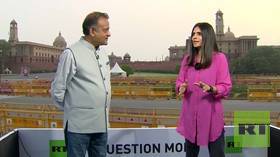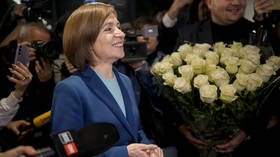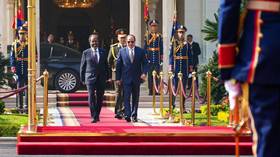Experts weigh in on tight race between Modi’s party and opposition (VIDEO)

The alliance led by the ruling Bharatiya Janata Party (BJP) appears set for a clear majority in India’s 543-member lower house of parliament (Lok Sabha), after vote counting got underway in the country early on Tuesday.
However, while the BJP-spearheaded National Democratic Alliance (NDA) is leading in more than 290 seats, the BJP itself – led by Prime Minister Narendra Modi – does not seem set to claim a parliamentary majority on its own.
The opposition INDIA bloc, at the same time, is tallying at 231 seats – defying exit poll predictions – as vote counting continues.
A total of 272 seats is needed for a party or coalition to form the government. The BJP came to power in 2014, winning 336 seats along with its NDA allies. In 2019, the NDA claimed a total of 352 seats. At least three exit polls in the current election, released moments after voting wrapped up on June 1, predicted that the BJP-led alliance would win more than 360 parliamentary seats.
According to Vikas Gupta, political commentator and senior advocate, the striking difference between this year’s election and the ones in 2014 and 2019 is that the Modi-led BJP had previously crossed the 272-seat mark required to have a majority on its own, even without allies.
“This was the first time when they were not able to cross the mark, and they fall short by almost 30 seats. What is interesting is that pre-poll allies may go with the NDA [alliance] or may switch to [opposition] INDIA bloc,” Gupta suggested. “It’s a million-dollar question, who will eventually form the government,” he observed.
Several experts interviewed by RT in New Delhi as voting was underway underscored that the results had become unpredictable, as a “tight fight” between the ruling party and the opposition had not been expected, indicating that the interim outcome proves the elections were fair and democratic – despite their credibility being questioned by some international media. “Democracy strengthened its roots, and that’s where India wins today,” Gupta concluded.
Meanwhile, the markets on Tuesday reacted sharply to the election trends, suffering their worst fall since March 2020, when the Covid-19 pandemic struck. As early vote counting suggested the BJP-led alliance was unlikely to win a decisive majority, the stocks market plummeted, erasing $386 billion in value after a huge rally the previous day, according to Bloomberg. The rupee also slid as the election results triggered broad-based dollar demand.
According to Rami Niranjan Desai, a political analyst who spoke to RT earlier on Tuesday, this response is because the Modi-led government has been “very pro-market.”
However, the “greater worry” is that India should have a “solid government,” Desai noted, adding that coalitions in India do not function as adeptly as they should. According to Desai, “anti-incumbency” may have played a role in the BJP receiving a smaller mandate this time.
Where India Meets Russia: Follow and share RT India on X and Instagram












